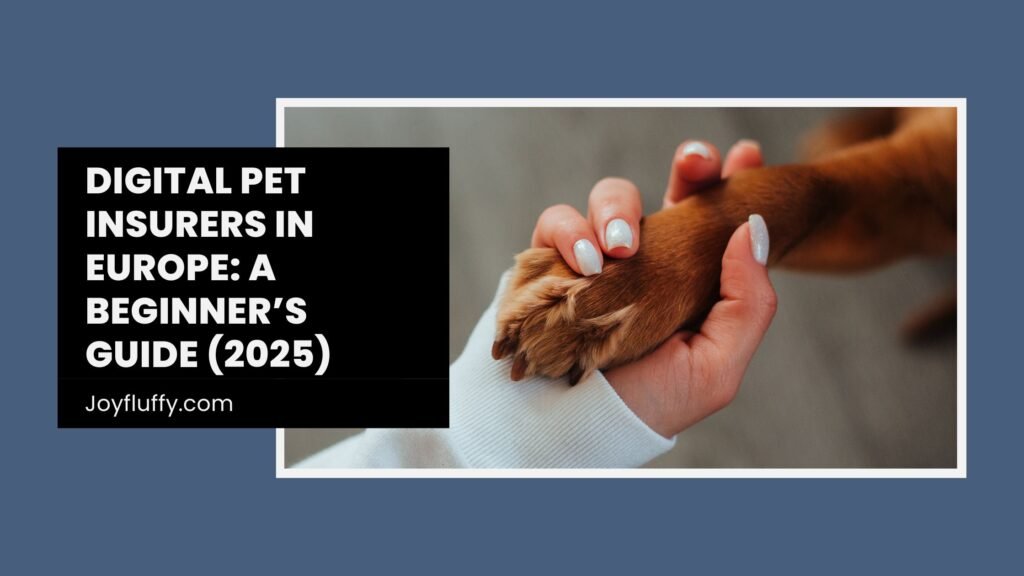Micro-Insurance & Digital Pet Insurers in Europe: A Beginner’s Guide (2025)

The cost of veterinary care keeps climbing, and more pet owners are looking for affordable ways to protect their furry friends. That’s where micro-insurance and a new wave of digital pet insurers come in — smaller, simpler, often app-based plans designed for flexibility and low monthly cost. In Europe, these products are starting to attract attention from budget-conscious owners and expats who want fast, no-fuss cover. Here’s what you need to know as a pet owner in 2025.
What is micro-insurance for pets?
Micro-insurance generally means insurance with low premiums and lower coverage limits, built to be affordable and easy to buy. Traditionally the term has been used for social and health products in emerging markets, but insurers are applying the same principles to consumer products — including pets. Micro-pet plans typically cover a narrow set of events (accidents, short-term illness, or specific procedures) and keep monthly costs small.
Who is it for?
- Owners who want basic protection without a high monthly bill.
- People with young, healthy pets (lower likelihood of chronic claims).
- Travelers and expats who want short-term or portable cover.
Typical features:
- Small monthly premiums.
- Lower annual or per-incident limits than full policies.
- Shorter or simpler application and claims processes.
- Often sold and managed entirely via apps or online dashboards.
Why digital insurers are leading the micro-insurance wave
Digital-first insurers shave costs by automating onboarding, underwriting and claims handling. Without heavy branch networks and paperwork, they can offer faster quotes and a simpler UX — ideal for a pet owner who wants to sign up on their phone in under 10 minutes. European players such as Feather, Getsafe, and ManyPets have been expanding their product ranges and promoting app-based convenience. These companies are examples of the insurtech push that’s reshaping how pet cover is bought and managed.
Example snapshots:
- Feather — targets expats and app users with simple, modular pet health policies and a strong digital onboarding experience. Feather Insurance+1
- Getsafe — promoted as a 100% digital, English-friendly insurer in markets like Germany, offering flexible plans and quick digital claims. hellogetsafe.com+1
- ManyPets — established player with lifetime policies and travel cover options, increasingly focused on online service and comparisons. ManyPets+1
Micro-insurance vs traditional pet insurance — pros & cons
Pros of micro-insurance
- Low monthly cost — easier on budget-conscious owners.
- Simplicity — straightforward terms and fewer paperwork hurdles.
- App convenience — fast claims and clear policy dashboards.
Cons to watch for
- Lower limits — big vet bills (e.g., complex surgery) may exceed coverage.
- Exclusions — chronic conditions and pre-existing conditions are often excluded.
- Frequent renewals or switches — short plans might require more admin to keep continuous cover.
A helpful approach is to match the plan to your pet’s profile: micro-insurance for a young, low-risk pet or as an emergency back-stop; full-cover lifetime policies for aging pets or breeds prone to chronic issues.
Real-life mini case studies
- Puppy vaccination & minor illness — a micro plan with per-incident limits easily covered routine vet visits and a short illness, making it cost-effective.
- Emergency surgery — micro-insurance with a low annual cap could leave the owner paying thousands out of pocket; full policy would be better.
- Chronic disease later in life — owners who started with micro cover often needed to switch to full cover later (which can be harder if pre-existing conditions develop).
These scenarios show why reading limits and exclusions matters before you click “buy.”
How to pick a micro-insurance plan — quick checklist
Before you buy:
- Check annual and per-incident limits.
- Read exclusions (pre-existing conditions, breed restrictions).
- Confirm waiting periods for illness vs accidents.
- Look at the claims process (app photos, vet invoices, time to payout).
- Compare cost vs benefit: monthly premium × 12 vs common vet bills in your country.
- Check portability if you travel or move between EU countries.
Tip: ask for sample policy wording or a one-page summary — reputable digital insurers provide clear examples online.
Regulation & cross-border issues in Europe
Europe’s pet insurance market is growing rapidly (estimates show multi-billion USD market size and strong CAGR), but rules and provider availability vary by country. Some digital insurers focus on single countries (e.g., Germany, UK), while others offer cross-border options for expats. Consumer protections differ by jurisdiction, so always check terms that apply to your country of residence. Grand View ResearchMordor Intelligence
Practical point: if you’re an expat or travel frequently within Europe, confirm whether the policy is valid in other coFuture outlook: what to expect
Expect more experimentation: pay-as-you-go models, microclaims, and bundles (insurance + tele-vet services + wellness plans). Insurtech entrants are likely to keep innovating on pricing and product formats, while comparison platforms will adapt to show these smaller products. As the market grows, consumer education (clear limits and examples) will be key. Feather InsuranceCognitive Market Researchuntries and how claims are handled abroad.
Where to start (quick steps for readers)
- Decide whether you want basic emergency cover or full lifetime cover.
- Get quotes from 2–3 digital insurers (Feather, Getsafe, ManyPets where available).
- Compare limits, exclusions and waiting periods — don’t just look at price.
- If you’re unsure, call the insurer’s customer support with a sample vet bill scenario to test response and clarity.
- Keep records of vet visits and invoices — they’ll speed up claims.
FAQ
Q: What does micro-insurance usually cover for pets?
A: Typically accidents, short-term illness, or few specified events. Always check the policy for exact inclusions and limits. Milliman
Q: Is micro-insurance worth it for older pets?
A: Usually not — older pets often have higher risk of chronic issues and micro plans’ low limits may leave owners with big out-of-pocket bills.
Q: Can I switch from micro-insurance to full cover later?
A: Often yes, but pre-existing conditions discovered while on a micro plan can affect eligibility and pricing for full cover later.
Q: Are digital insurers trustworthy?
A: Many are reputable — look for established names (reviews, third-party ratings), clear policy wording, and responsive claims support. Examples include Feather, Getsafe and ManyPets. Feather Insurancehellogetsafe.comManyPets
Q: Does micro-insurance cover pets while traveling in Europe?
A: Some plans do — always confirm cross-border validity and emergency care terms before travel. ManyPets
Sources & further reading
- Europe pet insurance market reports (Grand View Research). Grand View Research
- Feather (company product pages & blog). Feather Insurance+1
- Getsafe (pet product details). hellogetsafe.com+1
- ManyPets product pages (lifetime & travel cover). ManyPets+1
- Microinsurance definitions & research (Milliman / NCBI). MillimanPMC
[Chathu] — Pet writer & JoyFluffy founder. I write practical guides to help pet owners make caring, cost-wise decisions. I’m not a vet or insurance advisor — for medical or legal advice, check with a qualified veterinarian or insurance broker.





